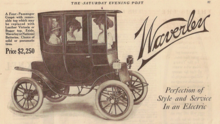Pope-Waverley


Pope-Waverley was one of the brands of the Pope Motor Car Company founded by Albert Augustus Pope and was a manufacturer of Brass Era electric automobiles in Indianapolis, Indiana. The company was originally formed as the Indiana Bicycle Company in 1898 changing to the American Bicycle Company in 1900. In 1903 it became the before joining the Pope group in 1903. From 1908 until production ceased in 1914 they became independent again as the Waverley Company.
Products[]
The 1904 Pope-Waverley Chelsea was a runabout model. It could seat 2 passengers and sold for US$1100. The single electric motor was situated at the rear of the car, and produced 3 hp (2.2 kW). The car used 30 batteries.
The 1904 Pope-Waverley Road Wagon was a smaller wagon model. It could seat 2 passengers with an open box at the rear for cargo and sold for US$850. The single electric motor was situated at the rear of the car and produced 3 hp (2.2 kW). The car used a 24-cell battery and could travel at 5 or 15 mph (8 or 24 km/h).
The 1904 Pope-Waverley Edison Battery Wagon was a runabout model with 48-cell Edison batteries. It could seat 2 passengers and sold for US$2250. The electric motor was situated at the rear of the car.
The 1904 Pope-Waverley Tonneau was a tonneau model. It could seat 5 passengers and sold for US$1800. Twin electric motors were situated at the rear of the car, producing 3 hp (2.2 kW) each with a special 12 hp (8.9 kW) overload mode. The armored wood-framed car used 40 batteries and could reach 15 mph (24 km/h).
References[]
- Frank Leslie's Popular Monthly (January, 1904)
External links[]
- Photo of ca. 1900 Waverly driven by Swan Turnblad at the Minnesota Historical Society.
- Veteran vehicles
- Electric vehicles introduced in the 20th century
- Defunct motor vehicle manufacturers of the United States
- Motor vehicle manufacturers based in Indiana
- Defunct companies based in Indiana
- Veteran auto stubs